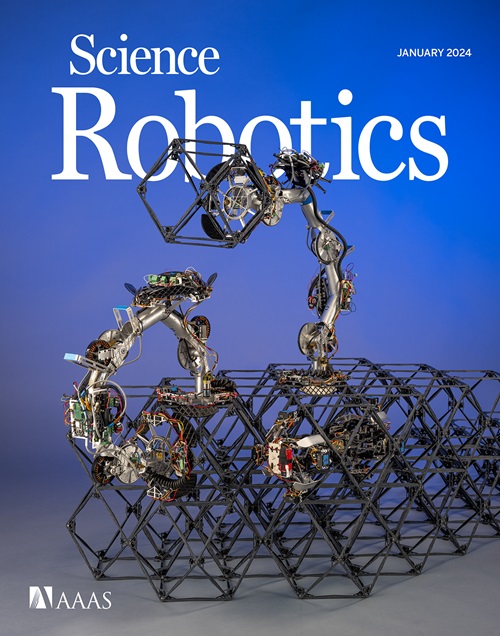用机器人操纵心肌细胞识别心律失常性心肌病的间隙连接修饰因子
IF 27.5
1区 计算机科学
Q1 ROBOTICS
引用次数: 0
摘要
心律失常性心肌病(ACM)是青壮年心脏性猝死的主要原因。间隙连接重塑异常与 plakophilin-2 (PKP2)的致病突变有关。虽然间隙连接是一个关键的治疗靶点,但在临床前疾病模型中测量间隙连接的功能在技术上具有挑战性。为了高精度、高一致性地量化间隙连接功能,我们开发了一种机器人细胞操纵系统,该系统利用数字全息显微镜的视觉反馈,对人类诱导多能干细胞衍生的心肌细胞(iPSC-CMs)进行三维无标记成像。该机器人系统能准确测定细胞收缩期和静息期的动态高度变化,以恒定的注射深度对静息期的健康和患病 iPSC-CMs 进行显微注射,并沉积仅通过间隙连接在细胞间扩散的膜渗透性染料,以测量间隙连接扩散功能。该机器人系统被用于靶向药物筛选,以确定间隙连接调节剂和治疗 ACM 的潜在疗法。结果发现,在 PKP2 被敲除的心肌细胞中,有五种化合物能按剂量依赖性地增强缝隙连接的通透性。此外,在表达突变型 PKP2(R735X)的 ACM 小鼠模型中,PCO 400(pinacidil)减少了跳动不规则性。这些结果凸显了机器人细胞操纵系统在相关临床前疾病模型中有效评估间隙连接功能的实用性,从而为推动治疗 ACM 和其他间隙连接介导疾病的药物发现提供了一种技术。本文章由计算机程序翻译,如有差异,请以英文原文为准。
Robotic manipulation of cardiomyocytes to identify gap junction modifiers for arrhythmogenic cardiomyopathy
Arrhythmogenic cardiomyopathy (ACM) is a leading cause of sudden cardiac death among young adults. Aberrant gap junction remodeling has been linked to disease-causative mutations in plakophilin-2 ( PKP2 ). Although gap junctions are a key therapeutic target, measurement of gap junction function in preclinical disease models is technically challenging. To quantify gap junction function with high precision and high consistency, we developed a robotic cell manipulation system with visual feedback from digital holographic microscopy for three-dimensional and label-free imaging of human induced pluripotent stem cell–derived cardiomyocytes (iPSC-CMs). The robotic system can accurately determine the dynamic height changes in the cells’ contraction and resting phases, microinject drug-treated healthy and diseased iPSC-CMs in their resting phase with constant injection depth across all cells, and deposit a membrane-impermeable dye that solely diffuses between cells through gap junctions for measuring the gap junction diffusion function. The robotic system was applied toward a targeted drug screen to identify gap junction modulators and potential therapeutics for ACM. Five compounds were found to dose-dependently enhance gap junction permeability in cardiomyocytes with PKP2 knockdown. In addition, PCO 400 (pinacidil) reduced beating irregularity in a mouse model of ACM expressing mutant PKP2 (R735X). These results highlight the utility of the robotic cell manipulation system to efficiently assess gap junction function in a relevant preclinical disease model, thus providing a technique to advance drug discovery for ACM and other gap junction–mediated diseases.
求助全文
通过发布文献求助,成功后即可免费获取论文全文。
去求助
来源期刊

Science Robotics
Mathematics-Control and Optimization
CiteScore
30.60
自引率
2.80%
发文量
83
期刊介绍:
Science Robotics publishes original, peer-reviewed, science- or engineering-based research articles that advance the field of robotics. The journal also features editor-commissioned Reviews. An international team of academic editors holds Science Robotics articles to the same high-quality standard that is the hallmark of the Science family of journals.
Sub-topics include: actuators, advanced materials, artificial Intelligence, autonomous vehicles, bio-inspired design, exoskeletons, fabrication, field robotics, human-robot interaction, humanoids, industrial robotics, kinematics, machine learning, material science, medical technology, motion planning and control, micro- and nano-robotics, multi-robot control, sensors, service robotics, social and ethical issues, soft robotics, and space, planetary and undersea exploration.
 求助内容:
求助内容: 应助结果提醒方式:
应助结果提醒方式:


